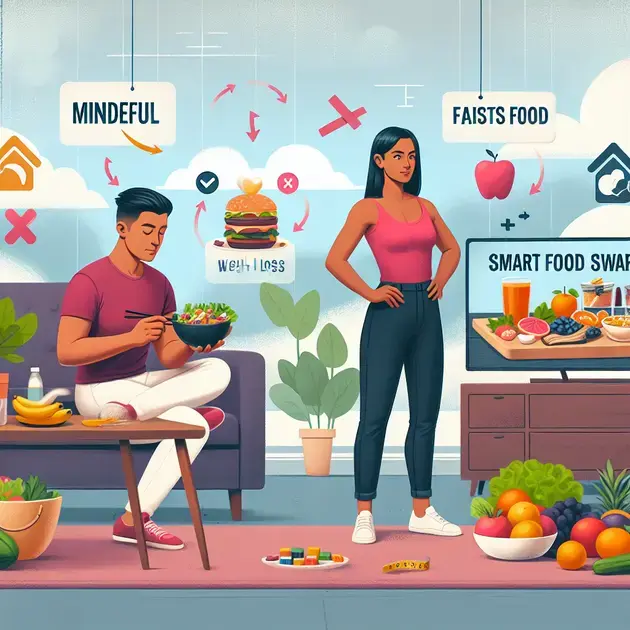Are you tired of sacrificing your favorite foods in order to lose weight? Look no further, because this post will provide you with effective strategies for weight loss without having to give up the food you love. With the right approach, you can achieve your weight loss goals while still enjoying delicious meals.
Recent studies have shown that it is possible to lose weight without completely eliminating certain food groups. By following a balanced diet and incorporating smart strategies into your lifestyle, you can successfully shed those extra pounds while still indulging in your favorite treats. Let’s explore some effective strategies for weight loss without sacrificing food.
Incorporating Smart Food Swaps
When it comes to incorporating smart food swaps into your diet for a healthier lifestyle, it’s essential to first identify areas where you can make small changes that will have a big impact. One easy swap is trading white rice for quinoa, a high-protein, fiber-rich alternative that will keep you feeling full and satisfied. You can easily find a variety of quinoa recipes on popular cooking websites like Food Network or Allrecipes.
Another smart food swap is replacing sugary drinks with infused water. By infusing your water with fruits like berries or citrus, you can enjoy a flavorful and refreshing beverage without the added sugars. Apps like “Plant Nanny” or “MyWater” can help you track your water intake and remind you to stay hydrated throughout the day.
For a healthier snack option, consider swapping out traditional potato chips for air-popped popcorn. Popcorn is a whole grain that is high in fiber and low in calories, making it a satisfying choice for when you’re craving something crunchy. Check out recipe ideas and nutritional information on platforms like “Popcorn.org” or “Skinny Pop.”
By making these simple and delicious food swaps, you can gradually improve your eating habits and move closer to your health and wellness goals. Remember to track your progress and celebrate your successes along the way!
Balanced Eating for Weight Loss Success
Achieving weight loss success through balanced eating requires a combination of mindful food choices and portion control. One effective strategy is to fill your plate with colorful fruits and vegetables, which are rich in vitamins, minerals, and fiber. Websites like “ChooseMyPlate.gov” offer guidance on building a balanced plate and creating healthy meal plans.
Another key aspect of balanced eating for weight loss is incorporating lean proteins like chicken, fish, or tofu into your meals. Protein helps you feel full and satisfied, reducing the likelihood of overeating. Apps like “MyFitnessPal” or “Lose It!” can assist you in tracking your protein intake and monitoring your daily caloric goals.
Avoiding processed foods and sugary snacks is crucial for maintaining a balanced diet and supporting your weight loss journey. Try meal prepping your lunches and snacks for the week ahead using resources like “MealPrepPro” or “Prepear” to stay organized and on track with your healthy eating goals.
Remember to listen to your body’s hunger cues, practice mindful eating, and seek support from health professionals or online communities for accountability and encouragement on your path to weight loss success.
Indulge in Guilt-Free Treats
Enjoying guilt-free treats doesn’t have to mean sacrificing flavor or satisfaction. One smart swap is opting for dark chocolate instead of milk chocolate, as dark chocolate contains less sugar and more antioxidants. Look for high-quality dark chocolate brands like “Lindt Excellence” or “Ghirardelli Intense Dark” for a decadent yet healthier dessert option.
Another guilt-free treat idea is to make homemade fruit sorbet using fresh fruits and a blender. Websites like “Minimalist Baker” or “Delish” feature simple sorbet recipes that are free from added sugars and artificial ingredients, allowing you to indulge in a sweet treat without the guilt.
For a savory snack alternative, air-fried crispy chickpeas are a satisfying and nutritious option. Apps like “Tasty” or “EatingWell” showcase various recipes for roasted chickpeas with different seasonings and flavor profiles, giving you plenty of options to satisfy your crunchy cravings.
By exploring these guilt-free treat options and getting creative in the kitchen, you can enjoy delicious desserts and snacks without derailing your health and wellness goals. Treat yourself in moderation and savor each bite knowing that you are nourishing your body with wholesome ingredients.
Incorporating Physical Activity
Physical activity is a key component of a healthy lifestyle, especially when it comes to weight management. Incorporating regular exercise into your routine can help you burn calories, improve your overall fitness levels, and boost your metabolism. To get started, try to find activities that you enjoy and that fit your schedule. This could be anything from going for a walk or jog in the mornings to joining a dance class or playing a sport with friends.
One effective way to incorporate physical activity into your daily life is to set specific goals for yourself. These goals should be realistic and achievable, such as aiming to exercise for at least 30 minutes a day or trying a new workout class once a week. By setting clear targets, you can stay motivated and track your progress over time.
Another tip for incorporating physical activity is to make it a social experience. Working out with a friend or joining a group fitness class can make exercise more enjoyable and help you stay accountable. Plus, having a workout buddy can provide extra support and encouragement along the way.
Remember that consistency is key when it comes to physical activity. Try to create a routine that works for you and stick to it as much as possible. Whether you prefer to exercise in the morning, during your lunch break, or in the evening, make sure to carve out dedicated time for physical activity in your schedule.
Overall, incorporating physical activity into your daily routine is essential for weight management and overall health. By finding activities you enjoy, setting realistic goals, making it a social experience, and staying consistent, you can make exercise a regular part of your lifestyle.
Mindful Eating Habits for Weight Management
Mindful eating is a powerful tool for weight management that involves paying attention to what, when, and how you eat. By being more mindful about your eating habits, you can make healthier choices, enjoy your food more, and prevent overeating. To start incorporating mindful eating into your routine, try the following steps:
Step 1: Slow Down
One of the key aspects of mindful eating is slowing down and savoring each bite. Take the time to chew your food thoroughly, put down your utensils between bites, and pay attention to the flavors and textures of your meal. Eating slowly can help you feel more satisfied and prevent you from overeating.
Step 2: Listen to Your Body
Pay attention to your hunger and fullness cues throughout the meal. Eat when you’re hungry and stop when you’re satisfied, even if there is still food left on your plate. Tuning in to your body’s signals can help you avoid mindless eating and better regulate your food intake.
Step 3: Eliminate Distractions
Avoid eating in front of the TV, computer, or while scrolling through your phone. Eliminating distractions during meals can help you focus on the experience of eating and tune in to your body’s hunger and fullness cues. By being present during meals, you can enjoy your food more and make healthier choices.
Step 4: Practice Gratitude
Before starting your meal, take a moment to express gratitude for the food in front of you. Reflect on where it came from, the efforts that went into preparing it, and the nourishment it provides your body. Cultivating a sense of gratitude can enhance your eating experience and promote a positive relationship with food.
Step 5: Be Kind to Yourself
Finally, remember to be kind to yourself throughout the mindful eating process. It’s normal to have moments of mindless eating or slip-ups, but the key is to practice self-compassion and continue making efforts to eat mindfully. By being gentle with yourself, you can develop a sustainable and positive approach to weight management through mindful eating.
Setting Realistic Goals for Sustainable Results
When it comes to achieving sustainable results in weight management, setting realistic goals is essential. Unrealistic expectations can lead to frustration, burnout, and ultimately, giving up on your health journey. To ensure long-term success, follow these steps for setting achievable and sustainable goals:
Step 1: Assess Your Current Situation
Before setting any goals, take stock of where you are currently at in terms of your weight, fitness level, and overall health. Consider what changes you would like to see and what areas you would like to improve. By understanding your starting point, you can set goals that are tailored to your specific needs and aspirations.
Step 2: Break Down Your Goals
Instead of setting one large, intimidating goal, break it down into smaller, manageable steps. For example, if your ultimate goal is to lose 20 pounds, set smaller milestones along the way, such as losing 2 pounds per week or incorporating more vegetables into your meals. Celebrating these mini victories can keep you motivated and on track.
Step 3: Make Your Goals SMART
SMART goals are specific, measurable, achievable, relevant, and time-bound. Instead of saying, “I want to lose weight,” make your goal more specific, such as “I want to lose 5 pounds in the next month by exercising three times a week and eating more fruits and vegetables.” By defining your goals in this way, you can track your progress and stay focused.
Step 4: Create Accountability
Share your goals with a friend, family member, or health coach who can provide support and hold you accountable. Setting goals publicly can help you stay motivated and committed to making positive changes. Additionally, consider tracking your progress in a journal or app to monitor your achievements and see how far you’ve come.
Step 5: Adjust and Reassess
As you work towards your goals, be open to adjusting them based on your progress and feedback. If you find that a particular goal is too challenging or not producing the results you want, don’t be afraid to modify it. Regularly reassess your goals and make changes as needed to ensure they remain achievable and aligned with your long-term vision.
**
Conclusion
**
Incorporating physical activity into your daily routine is not just beneficial for weight management but also crucial for overall health. By finding enjoyable activities, setting realistic goals, making it a social experience, and maintaining consistency, you can make exercise a natural part of your lifestyle. Remember, the key is to create a routine that suits you best, whether you prefer morning workouts, lunchtime exercise, or evening sessions. By dedicating time to physical activity, you are investing in your well-being and long-term health.
When it comes to mindful eating, paying attention to what, when, and how you eat can significantly impact weight management. Through practices like slowing down, listening to your body’s cues, eliminating distractions, practicing gratitude, and being kind to yourself, you can develop a healthier relationship with food. Mindful eating allows you to make better food choices, enjoy your meals, and prevent overeating by being more present during your eating experiences.
Setting realistic goals is essential for sustainable results in weight management. By assessing your current situation, breaking down your goals into achievable steps, making them SMART, creating accountability, and being open to adjustments, you pave the way for long-term success. Remember that progress takes time, and celebrating small victories along the way can keep you motivated and on track towards reaching your ultimate health and fitness objectives.

